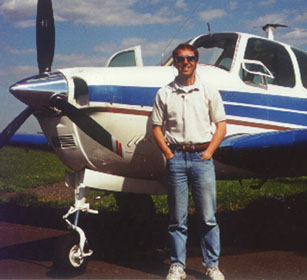|
Updated September 7, 2005
Datalink Weather Service Comparison
I've done some web research in preparation for a talk I gave at the American Bonanza
Society Annual Convention in Dallas, TX on September 9, 2005. I've put together an
Excel spreadsheet that compares the
weather products from three datalink weather providers: WxWorx XM, WSI, and
Bendix/King FIS. Another worksheet in the file then compares, for each service provider,
which weather products can be displayed on different devices including MFD's (Avidyne
FlightMax EX500, MX-20, Garmin 1000), GPS units (Garmin 430/530), and portable
units (laptops, electronic flight bags, PDA's, and the Garmin 396).
To download the Excel spreadsheet, if clicking the above link does not work, try right-clicking on it and choose the "Save link as" or "Save target as".
Feel free to explore on your own. These links provide a starting point:
Weather Data Providers
WxWorx: www.wxworx.com
product specifications with update intervals: http://www.xmradio.com/weather/xmwm_productdefs.pdf
images of weather products: http://www.xmradio.com/weather/learn_about.html
WSI – product specifications and pricing
http://www.wsi.com/solutions/aviation/inflight/pricing.asp
Bendix/King Flight Information Services (FIS)
https://www3.bendixking.com/wingman/static/FIS/faq.jsp
Display Device and Software Providers
Portable devices
NAVAir: www.airgator.com
PDA, EFB and Laptop packages:
http://www.airgator.com/Saves/pricing.htm
Anywhere Map, Anywhere WX: www.controlvision.com
PDA solutions & comparison with Garmin 396:
http://www.controlvision.com/pages/awm-vs-396.aspx
EFB packages:
http://www.anywheremap.com/SearchResult.aspx?CategoryID=26
Garmin 396
http://www.garmin.com/products/gpsmap396/
Panel mounted devices
Avidyne FlightMax EX500
http://www.avidyne.com/ex500
Garmin info on GDL 69/69A (GNS 430/530, MX20, G1000)
http://www.garmin.com/products/gdl69
Bendix/King Flight Information Services (KMD 250/550/850)
https://www3.bendixking.com/wingman/static/FIS/faq.jsp
-----------------------------------------------
Last updated October 12, 2004
Over the past two years, satellite systems for delivering
aviation weather services to general aviation aircraft have
become very usable. Prices for these systems have also dropped
significantly. You can now obtain a complete handheld wireless
weather solution utilizing geosynchronous satellites for
under $2,000. This market continues to evolve and change
rapidly.
This page deals primarily with handheld solutions. The
market for panel-mount hardware is also developing rapidly
but is only covered here in passing.
XM Satellite System
This is one of the least expensive systems available, while
remaining extremely capable. XM aviation weather data uses the same satellites that can deliver
XM Radio to your car or airplane, though you need a special receiver to get the weather data. These satellites are geosynchronous,
so you have continuous coverage while flying in North America.
At this time, XM Nexrad maps can be displayed on a variety
of handheld devices including PDA's running Windows software
(e.g. HP/Compaq iPaq), certain Electronic Flight Bags (EFB's),
and most laptops. See the WxWorx web site for portable solutions.
XM weather data can be displayed on a few panel-mount
MFD's. The Avidyne FlightMax 500, available now, uses XM weather data with their "NarrowCast" service, and Garmin will be using XM weather data with their new Garmin
1000 system.
Side note about Garmin and weather data: the weather provider for the Garmin
430/530 units is Orbcomm, which utilizes a low earth orbit
(LEO) satellite network that has significant limitations. Most notable is that using
a LEO system, there are gaps in coverage that can last for
tens of minutes, and sometimes more than an hour. You would
be better served going with a geosynchronous satellite delivery
system. Garmin does NOT provide geosynchronous weather data for the Garmin
430/530 and probably never will be due to the contracts
they have already signed with Orbcomm.
Great GPS, sub-par wx service.
Interestingly, WSI announced in the summer of 2004 that they have a unit that can display wx data from their geosynchronous satellite system on the Garmin 430/530. Garmin is not happy about this and has been trying to discourage 430/530 owners from buying into this. I would suggest researching this option carefully before purchasing.
One excellent solution for the Garmin 430/530 is to pair a 430 or 530 with the Apollo (now GarminAT) MX-20. The MX-20 can be driven by nearly any modern GPS, including a Garmin 430/530. You could then subscribe to WSI's geosynchronous weather data service, which is available for the MX-20. More information about that below... And if you want my opinion, I'd recommend using a 530 with the MX-20. The Nav-1 page on the 530 is superior to the data available on the 430. You'll enjoy the larger screen too, as well as the dedicated VOR/ILS ID, radial, and distance window, not available on the 430.
Back to XM weather data and PDA's.
A complete XM weather data system includes a display device, a GPS
that must be connected to the display device, a weather data receiver,
and an XM antenna for the data receiver. All of this can
remain portable (this is the best solution available if
you fly in multiple aircraft). Both the XM antenna and the
GPS antennas can be placed on the dash board of the airplane
and work well. With a bluetooth enabled display device,
you could also use a bluetooth GPS (i.e. wireless), which
helps cut down on cable clutter.
As is normal for geosynchronous satellite data systems,
the satellites will push current data to your display device
every five minutes automatically. This is the best way to
get your data, as the user does not need to make a data
request as is often required with LEO systems.
Check out airgator.com
for bundled solutions starting at less than $2000. See WxWorx.com
for information about the data and subscription fees (about
$50/month).
Control Vision, Anywhere Map, AnywhereWx, Satellite
phone system
A weather data solution that uses a satellite phone has been available for several years from ControlVision, the makers of AnywhereMap. The only configuration
I've seen is using a Windows based PDA (e.g. HP/Compaq iPaq
or similar) as the display device. If you want to use an
EFB or a laptop, you'll have to investigate that yourself.
A complete system would require a PDA, a GPS for the PDA
(a wireless bluetooth GPS will work with an appropriate
PDA), both the Anywhere Map and AnywhereWx software, and
a satellite phone that is used to retrieve data on demand.
Complete packages are available from ControlVision.com.
In 2004 ControlVision has made available an XM weather data solution as well. So if you like the AnywhereMap software, you now have two data solutions - satellite phone, or XM weather data.
Differences between the satellite phone option vs. an XM data provider: XM solutions at this point require a subscription to the data service which costs about $50/month. XM data is updated automatically every five minutes. With the satellite phone, data is provided only on request, and you pay
for each satellite phone call. This can be
a benefit if you only fly occasionally, as you may be able
to keep your data costs below $50/month. However, this also
makes the system slightly more complicated. If you are a
computer geek, this will not be a problem. If you aren't
a computer geek, the XM system is easier
to set up, and easier to operate.
WSI geosynchronous satellite system
This is the only solution that can be used both with handheld
devices and panel mount devices. Note that the only panel
mount device that will interface with WSI at this time is
the GarminAT (formerly Apollo) MX-20. This is an
excellent panel mount MFD. (As of Summer 2004, you may be able to use the WSI system with a Garmin 430/530, but Garmin isn't happy about this.)
The WSI system consists of similar hardware components as the XM
system, except that the data antenna needs to be mounted
on the top of the aircraft. This does reduce cable clutter,
but obviously only possible if you own the aircraft. If
you are a renter or a CFI, this solution isn't for you.
The WSI system will interface with Windows-based PDA's,
EFB's, laptops, and the panel-mounted MX-20. This could
be an excellent solution if you want handheld capability
now, and are considering adding an MX-20 to your panel down
the road.
Also requires a data subscription, about $50/month. All
details at WSI.com.
There are numerous other solutions available for getting
some type of real-time weather data in the cockpit. If you
have a web-enabled cell phone or a PDA that can connect
to the internet with a radio service (like CDPD) or a cellular
service (like GPRS), you could potentially use it to surf
the web and get weather data.
One limitation is the legality of doing this while
flying. The FCC does have restrictions from using cellular
devices while flying in aircraft. See discussion under "Use
In Flight" below. Note that I am not a lawyer, nor
a legal expert in these matters. You need to determine the
legality of any such use yourself.
Another limitation is that many newer data-capable cell phones and PDA's are very low-power devices, which helps make the batteries last a long time. Owners who have tried to connect to a data service while airborne have reported significant difficulty in many cases. These devices are probably best utilized while on the ground at fuel stops or from your hangar.
The geosynchronous satellite solutions discussed in the previous section are superior
in that if you use a GPS with your display device, your
position will be shown in relationship to the weather. A
web-enabled cell phone or PDA may be able to get weather
maps, but won't show your position. Still, when I was using
my Palm Vx and OmniSky modem, this information was definitely
useful for making strategic weather decisions. The satellite
solutions above are more capable and 100% legal.
A while back I dropped my OmniSky modem on the ramp and destroyed it. So I am no longer using a Palm Vx/OmniSky modem for weather data.
Links and content below were last updated August 6, 2002.
No guarantee of its validity at this point in time. | 

